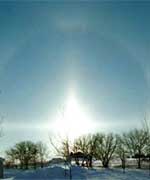
Image credit: NASA
To understand the Winter Solstice (and by contrast the Summer Solstice) we must first understand a fundamental fact about the earth. Earth?s axis of rotation is tilted approximately 23.5? from vertical. This means that as earth orbits the sun, it points first one hemisphere, then the other toward the sun. This tilt causes sunlight to strike the surface of earth at different angles at different times of year. In the summer, the sun is high overhead for the Northern hemisphere and the heat energy is concentrated over a smaller area. In the winter, when the angle of the sun is low, the energy covers a much larger area and therefore heats less efficiently.
Imagine pointing a flashlight directly at a piece of paper. It’ll create a bright circle of light concentrated in an area. Now tilt the flashlight so that it’s hitting the paper on an angle. The same amount of light is coming out of the flashlight, but it’s spread out over a much larger area of paper. It’s this changing of our angle towards the Sun that gives us seasons.
The season we call ?winter? begins on the Winter Solstice. The word Solstice means ?sun still?. But to understand the significance of the Winter Solstice, we must first go back in time to the Summer Solstice, or first day of summer. Starting on June 21st, the sun gradually loses altitude in the sky as seen at noon. By September 22nd, the sun?s noon time altitude is significantly lower in the sky. The process continues until December 21st. Around this date, the sun seems to hold its position in the sky and then slowly begins to climb northward again; hence the term ?sun still.? To ancient peoples, the Solstice was a significant point in the year.
Because ancient peoples knew nothing of the earth?s tilt, the southward march of the sun was a troubling time. There was fear that one day the sun might continue moving south until was lost entirely. Many cultures conducted rituals to encourage the sun to move north again and when it did there were great celebrations. These celebrations, regardless of culture, all had a common theme that of rekindled light.
Not surprising then that many of the traditions and customs of ancient Solstice celebrations have survived to the present day. Although we know that the sun will begin moving north without any encouragement from humans, we still use this time of cold and darkness to celebrate the theme of rekindled light. From the Hanukah Menorah, to the Scandinavian Yule log, to the lights of the Christmas tree, during this season we seek to push back the darkness with light. Although the forms have evolved over the centuries, we cans still see the spirit of many of the old ways in our present day Solstice celebrations.
Now here is an interesting question to ponder, if the earth were not tilted and we had no seasons, would we celebrate the holidays in the same way?
Written by Rod Kennedy
